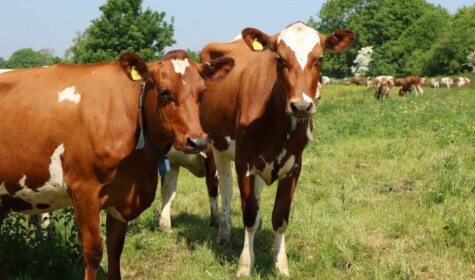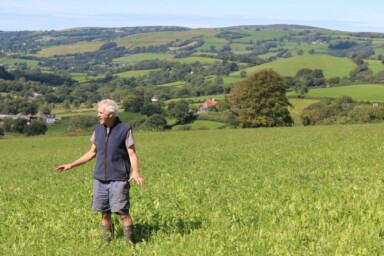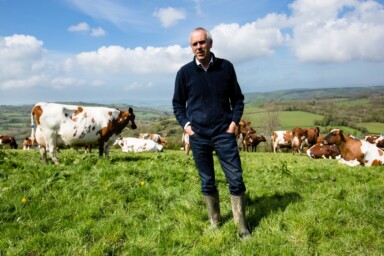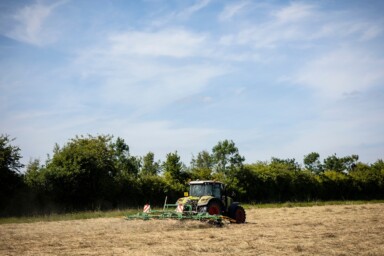The Sustainable Food Trust submitted a response to the government’s call for evidence on controlling live exports for slaughter and to improve animal welfare during transport after the UK leaves the EU. We reiterate the importance of slaughtering as close to the point of production as possible.
“The UK Government would prefer animals to be slaughtered close to the point of production, and considers that a trade in meat and meat products is more desirable than the long distance transport of animals specifically for slaughter. It is important to emphasise that any future proposed UK Government reforms should be grounded and justified in terms of delivering animal welfare objectives.”
Q2: We would welcome your views on how well current welfare in transport requirements and standards are currently working.
a) What are the key current regulatory requirements that you think protect the welfare needs of animals during transport?
b) What issues or deficiencies in the current regulations are you aware of?
c) What do you consider are the most important considerations for improving animal welfare during the transport of animals or related operations? Please indicate if your priority areas are species specific.
All species
One major welfare problem with long journeys is the tension between the desire of farmers and abattoir owners that animals should be fasted prior to loading to reduce faecal contamination of carcases during transport and the stress caused to the animals by a long fast. We suggest this is a powerful reason to find ways, through legislation, fuel taxation and vehicle licensing to discourage long distance transport and to encourage instead the slaughtering of animals near to the point of production, with the carcases transported (where necessary) instead of the live animals.
In the case of mono-gastric animals, such as pigs and poultry, their high metabolic rate means that not eating at their normal meal intervals is highly stressful, especially so for chickens. Research for the Food Standards Agency (see paragraphs 4.22 – 4.25) has also shown that, contrary to expectations, levels of campylobacter in live chickens increase rather than decrease when the animals are fasted. And laboratory research at Bristol University has indicated that when chickens are stressed the release of stress hormones causes campylobacter to migrate through the gut wall into the blood stream via which they end up deep within the muscle. Here they pose a significantly increased risk of food poisoning, since the meat requires more thorough cooking to kill them than when they are only present on the outside of the meat due to gut content spillage during slaughter and evisceration. As such we would recommend a complete ban on fasting chickens before transport.
Cattle and sheep
Ensuring ease of loading and unloading is crucial. Livestock trailers behind 4-wheel drive vehicles should be preferred to lorries wherever possible because the ramps are much less steep. Where lorries are used, purpose-built concrete loading ramps should be available on farms and at the destination, be that a market or an abattoir. Most farmers, however, cannot afford to construct these so grant aid could be considered. Although some transport firms have a few lorries where the loading height can be reduced for loading and unloading, the slope is still significantly steeper than with a livestock trailer, so stress can still occur. Slope is an even bigger issue with multiple deck transporters.
Ideally the density of cattle and sheep on long journeys of more than 4 hours should permit the animals to lie down, preferably on straw or some other suitable material.
The speeds of vehicles transporting cattle and sheep should be restricted to a maximum of 40 MPH on all roads, except dual carriageways and motorways, to reduce the extent to which the animals are thrown sideways or adversely affected by bumps due to uneven road surfaces.
While ideally cattle in particular ought to be given an opportunity to rest and drink every 4 hours, there should at least be a legal requirement on farmers to ensure that prior to loading and after unloading cattle are held in lairage where there is adequate clean water, available in a form they are used to using. E.g. water bowls should not be relied on for animals that have only ever drunk out of open water troughs, since it can take some time for them to learn how to use them. Given that most abattoirs have water bowls in lairage rather than troughs, farmers sending animals on journeys of 8 hours or more should be required to declare whether their animals are used to using water bowls. If they are not, the receiving abattoir should initially hold them quietly in lairage with water troughs before moving them to other lairage.
Pigs and poultry
We feel that under no circumstances should pigs and poultry for slaughter be transported on journeys longer than 4 hours, unless, in the case of pigs, they have sufficient space to lie down comfortably on bedding and have access to clean water at no more than 4-hourly intervals.
d) The current EU regulation requires transporters to reach a higher standard if they are transporting animals on long journeys i.e. more than 8 hours. How do you think we should define long journeys?
Our view is that the maximum journey time without rest and water should be 4 hours rather than 8 hours. We support the current approach of more stringent requirements for longer journeys but feel these should start after 4 hours and become progressively more stringent the longer the journey.
e) What evidence do you have that journey length influences the welfare conditions for animals?
Research (chapter 21) detailed by Professor Donald Broom from Cambridge University shows that sheep will naturally choose to lie down during transport after 2-4 hours and that cattle generally take a little longer to lie down. However, as he points out, the uneven sideways and for and aft movement of animals during road transport prevents them from settling earlier. But, neither cattle nor sheep transported long distances in the UK are given sufficient space to lie down.
While the welfare of animals can be difficult to measure directly, it should be noted that for a significant proportion of animals the only journey they ever go on is the one when they go to be slaughtered. As such there is inevitably emotional stress for them in being removed from their normal surroundings and fellow animals. By extension, since such stress (often audible in the form of bellowing or calling) will normally last several days, the longer the time between departure and slaughter the greater the extent of the animals’ distress.
Cattle with firm faeces prior to slaughter generally produce diarrhoea during the journey. This is a clear sign of stress and animals under stress have less than optimum welfare.
Mammals, including humans but with the partial exception of horses, naturally choose to sit or lie down to rest. Under most current commercial livestock transport conditions this is not possible. Therefore, the longer the transport the greater the stress and the lower the welfare.
f) On long journeys, the regulation currently requires rest stops to allow the animals to recover before continuing their journey. There is no limit on the number of rest stops required nor a maximum journey limit.
Do you believe there should be a maximum number of rest stops? Please indicate which species you are referring to.
For all farm animals destined for slaughter we feel there should be no permitted stops, to the extent that journeys should not be allowed to continue beyond the maximum journey time.
Do you believe that there should be a maximum journey limit? Please indicate which species you are referring to.
For pigs and poultry we feel the maximum journey time should be 4 hours and should not be longer than this unless the animals are unloaded and housed in comfortable conditions with food and water for at least 24 hours.
For cattle and sheep we feel the 8-hour journey should be the maximum permitted and that longer journeys than this should only be permitted if the animals are unloaded, fed, watered and rested for at least 24 hours.
g) What evidence do you have on how the different forms of transport (road, rail, sea, air) affect animal welfare? Please indicate which species you are referring to.
Our experience relates only to road transport and predominantly to cattle, sheep and pigs. Our evidence is largely based on personal observation during a total of almost 100 years of livestock farming by three staff members who are also famers. Our evidence in relation to poultry comes from published papers and other written material.
h) Do you have any evidence on the transport of unweaned animals? What age related conditions do you think should apply?
We are aware that pigs weaned at less than 7 weeks are highly prone to bacterial infections, especially those caused by E. coli. Such animals generally require treatment with anti-bacterials, some of which have been linked to the spread of antimicrobial resistance genes. As such we would advise against the transport of pigs less than 7 weeks old since the animals are likely to be stressed anyway and the transport itself is a vector for the environmental dissemination of antimicrobial resistance of significance to both humans and animals.
i) What conditions do you think should apply to animals post transport? Please indicate which species you are referring to.
We feel that very different considerations apply to animals that have travelled short distances slowly compared with long distances at speed. In the case of the former we see no reason why, and some advantages, if mammals are slaughtered shortly after arrival at an abattoir, subject to ante-mortem checks. In the case of animals that have travelled for up to 8 hours we feel they should be rested and given water (currently required) but that the resting period should not be unduly long unless the animals are fed. Cattle and sheep can withstand longer journeys than pigs and poultry but in our view should not be made to go for more than 18 hours in total without food, counting any fasting before the journey, the journey itself and the rest and wait at the abattoir.
j) How do you think “fitness to travel” should be defined? Please provide an explanation for your answer. Please indicate which species you are referring to.
Clearly only animals that are healthy (in terms of infection) should be transported. In relation to lameness however, the reality is that for some cattle and sheep, chronic lameness can develop as the animals age. In such cases, permitting the animals to be transported to slaughter can have welfare benefits over and above preventing this and forcing farmers to engage in a further round of antimicrobial and/or other treatment which may itself be painful and may not always be successful at that stage in the animal’s life. However, we would argue that animals with significant chronic lameness should be transported individually, allowed to load and unload slowly and be provided with adequate bedding to encourage them to lie down during transport.
Q3: We would welcome your views on possible future reform ideas
a) Does the journey end point i.e. slaughterhouse or production facility influence animal welfare? Please provide an explanation for your answer. Not really to any significant extent.
b) Do you think that a ban on live animal exports, or imports, should apply? If so, for what purpose i.e. slaughter, production. Please give reasons for your response.
We feel all efforts should be made to discourage live exports, especially where the animals may then travel significant additional distances by road in another country. This could be achieved by increased fuel duty, or licensing fees, justified in relation to greenhouse emissions and air pollution, and by shorter journeys overall. However, we would suggest that it may be difficult to ban live exports outright when distances from some Scottish islands to the mainland are greater than the distance across the Channel. A necessary pre-requisite to a ban on live exports would therefore be to ensure that all slaughter animals on UK islands could be slaughtered on the island or on one of a closely linked group of islands.
c) Currently, under the Regulation, livestock vessels (which keep animals in pens) and lorries require specific pre-approval inspections, whereas roll-on, roll-off vessels or aircrafts do not. Do you think that all transporters should be inspected and approved? If so, why?
Clearly all transport vehicles should be subject to similar checks because academic studies suggest that while conditions in some are excellent, they are far from adequate in others.
d) What other factors should be considered and addressed to improve the welfare of animals during transport?
The support and development of the UK’s network of smaller abattoirs has considerable welfare benefits through significantly shorter journey times for animals, and should be part of all levels of government policy.
e) Do you have any other proposed UK Government policy reforms?
Immediately replicate the assistance given to smaller abattoirs in Wales to all other areas of the UK.
Carry out a detailed inquiry into the decline in numbers of smaller abattoirs, in order to understand the problems facing such business owners.
Work with the industry to develop urgent policies to reverse the recent trend of closures of such abattoirs, and enable new businesses to be established, including on-farm slaughter, using both mobile and static facilities.
The Campaign for Local Abattoirs was set up to help ensure a sustainable future for a UK-wide network of smaller local abattoirs, through lobbying the UK governments to take urgent action, and by working with the industry and governments to find longer-term solutions to the problems facing the sector, including enabling the establishment of mobile abattoirs for on-farm slaughter.
We wholeheartedly agree with the statement in this consultation document that, “The UK Government would prefer animals to be slaughtered close to the point of production, and considers that a trade in meat and meat products is more desirable than the long distance transport of animals specifically for slaughter.”
Unfortunately, the rapid closure of smaller, local abattoirs is forcing many farmers to travel longer and longer distances to take their animals to slaughter. Between 2007 and 2017 a third of small abattoirs closed down, from already low numbers, three more red meat abattoirs have already closed this year (two of them low throughput) and others are known to be considering closure.
Smaller local abattoirs are essential for producer-retailers as they return the carcass to the farmer. This enables the local marketing of meat, which often has high welfare, organic, grass-fed, rare breed or heritage breed status. All livestock also need access to local slaughtering facilities for casualty slaughter.
With well over two-thirds of UK farmland under grass (71.5% of the total utilised agricultural area), it is clear how significant livestock farming is in the UK.
The decline in abattoirs is therefore highly alarming and could seriously undermine the future of local meat production.
The driving factors behind the closure of so many smaller abattoirs over the past decade in particular are complex and need careful examination and analysis.
However, a number of major reasons can be summarised as:
- Strong downward pressure on profitability from high volume abattoirs supplying mass markets at low margins,
- Increased costs of waste disposal,
- Excessive regulation hitting smaller businesses disproportionately,
- Low prices paid to small abattoirs for hides and skins,
- Planning hurdles which face those seeking to establish new small abattoirs.
The essential problem is that smaller, local abattoirs with short, local supply chains and markets, are forced to operate in a legislative and commercial environment which is designed for the high-volume operators, whose structure, management, methods, supply chains and markets are totally different from those of the traditional smaller local abattoirs. This puts the smaller plants at a built-in financial disadvantage, with no balancing benefits for the significant public goods they produce.
When it comes to transportation and animal welfare, the continuation of these small, local abattoirs is clearly critical. There is considerable public demand for high standards of animal welfare. By publicly recognising the importance of local, smaller-scale slaughtering facilities and acting to protect and enhance them, the government would demonstrate its commitment to animal welfare. Apart from much reduced travel times, smaller local facilities often provide a less stressful environment, more attentive staff and a more personal experience for the farmer.
When buying meat, many consumers want to be able to know and trust how the animal was reared and slaughtered. If buying local meat the expectation is that it has also been slaughtered and butchered locally. It is misleading to call something locally produced if it has had to travel long distances, and many consumers concerned with animal welfare would not be happy purchasing such a product if this was made known.
The option to slaughter animals on-farm could be considered. With mobile abattoirs already operating across many Western countries, it should be possible to ensure the high standards of meat hygiene rightly demanded by consumers is bureaucratically possible within a system of on-farm slaughter. Government should consider practical options to enable mobile or static on-farm slaughter of animals where appropriate.
Minimising the distance that animals must travel for slaughter also reduces the risk of spreading diseases such as Foot and Mouth Disease, were another outbreak to occur, something which could save the government and taxpayers a vast amount of money and many farmers a great deal of stress and heartache. Shorter journeys also mean that animals arrive at the abattoir with less faecal contamination, and therefore pose a lower health risk to consumers and abattoir staff. Smaller facilities with fewer animals will also reduce the risk of disease. Again, on-farm slaughter, using a mobile abattoir is the ultimate in this regard, with no mixing of animals, as is the case in a normal abattoir.







